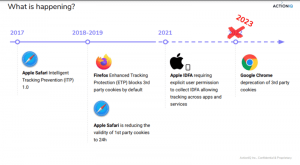If you’re blogging for your business, you probably already know the stats.
B2B marketers who blog receive 67% more leads than those who don’t. Marketers who prioritise blogging are 13x more likely to see positive ROI. Businesses who blog receive 97% more links to their website.
But you know all that. You know that there are a million reasons why blogging can be extremely beneficial to your business.
However, you also probably know that every time you post one of your thoughtful, insightful, carefully crafted blog posts, a million other bloggers are doing the exact same thing. (That’s not an exaggeration, by the way. In 2014, there were 1.5 million posts on WordPress every single day.)
That knowledge can be disheartening – after all, with so much blog content being pumped out every day, how do you make sure the content you’re putting out there stands out from the rest?
Today, I want to look at the five biggest mistakes bloggers make that turn readers off, so you can learn to avoid them.
Mistake #1: Clichés
An acquaintance of mine used to have a fashion blog, where she’d post her outfit of the day, and outline where she’d purchased each item. Every time I read her blog, one thing jumped out at me.
She was really fond of the phrase ‘… and I’m good to go!’
As in, ‘I just throw on a blazer over the top and I’m good to go!’
Once I noticed it, I couldn’t unsee it. It drove me to distraction. I haven’t read her blog in over a year now, because every time I saw ‘and I’m good to go!’, my right eye would start twitching.
The fact that most bloggers aren’t professional writers is part of the appeal for readers, but it does mean that we can be prone to using tired literary devices, including clichés. Especially clichés.
While hardly comprehensive, here’s a list of some of the phrases I’ve noticed are frequently overused by bloggers:
- A matter of time
- All’s well that ends well
- The writing on the wall
- Every cloud has a silver lining
- Read between the lines
- The quiet before the storm
- At the end of the day
By taking steps to exclude cliches from your writing (and believe me, I know that it can be difficult), you’re ensuring your content is both unique and authoritative. The list I’ve included is just a sample, of course (you can find a thoroughly comprehensive list here), but if you avoid those to begin with, you’re off to a great start.
Mistake 2: Bad header images
So many bloggers spend hours conceptualizing, researching, writing and proof-reading an article, then pop a terrible stock image on it and call it a day. I find this staggering – it’s like spending hours making a beautiful meal, then eating it with your hands off a paper plate. Why not go to the effort of presenting something you’ve worked hard on in a beautiful way?
The key to creating a great header image is to avoid using tired, overused images that we’ve all seen a thousand times.
You know the ones I mean. A pile of coins with a plant sprouting out of it for an article on investment. A golden egg in a nest for an article on retirement. A photo of two men in suits shaking hands and smiling beatifically for an article on business.
Take the time to find a beautiful, unique image for your article, which may mean choosing something that’s a little esoteric. Pixabay, Morguefile and Death to Stock are all great resources.
Depending on the blog you’re posting your article to, you may need to layer your article title on top of your chosen image, using photo editing software. While Photoshop is obviously hegemonic, free online resources such as Pixlr and Fotor are absolutely fine for this purpose. Just remember two things:
- Make sure you know the dimensions your header needs to be, to ensure your title isn’t cut off at all
- Choose your fonts judiciously; a tasteful font (I generally prefer sans-serif) is your best bet
Mistake 3: Shameless self-promotion
An indelible fact of life is that people hate being sold to, which is why I always take a wide berth around those people trying to push credit cards in shopping malls.
Blogs are great for positioning yourself as a subject matter expert and building your brand, but they’re not a sales tool. If your blog posts are little more than thinly-veiled ads for your product or service, you’re wasting time creating content that no one really wants to read.
The way most bloggers do this is to write an article discussing a particular (often exaggerated) problem at length, then explaining how their product or service can solve that problem. This, incidentally, is the exact same formula infomercials use.
Rather than shamelessly shoving sales spiels in the faces of your readers, you’re better off taking the time to create meaningful, valuable content for your readers.
Mistake 4: Bad grammar, spelling, and punctuation
Fun fact: I once dated a guy who forgot that ‘they’re’ was a word – he’d been using ‘their’ in its place for years before I pointed it out.
Actually, that might not be fun as much as it is sad.
As I mentioned earlier, when I discussed cliches, bloggers are generally not professional writers, which means things like spelling and grammar can fall through the cracks. They’re/their/there is just one of a few incredibly common mistakes that even the most conscientious of bloggers makes every now and then. Thankfully, you don’t need to be an English major to write a strong, grammatically correct blog post. You just need to steer clear of the most common – and therefore most vexing – spelling and grammar mistakes people make.
- They’re vs their vs there (use they’re for they are, use their to refer to something belonging to a group of people, and there everywhere else)
- Lose vs loose (to lose is to get rid of something, loose is something that isn’t tight)
- It’s vs its (use it’s to means it is, and its everywhere else)
- i.e. vs e.g. (use i.e to mean that is, and e.g when you have an example to give)
- Ellipses are comprised of three dots, and only three dots
There are plenty more errors (this list is a great resource) that bloggers frequently make that you may want to acquaint yourself with. After all, wouldn’t it be a shame if someone dismissed your blog, simply because you mixed up lose and loose?
Mistake #5: Writing what you want to read, not what your audience wants to read
Trying to think of fresh new topics for your blog can be uphill battle at times. When you’ve been blogging for awhile, you’ve probably already covered all of the topics you know inside and out, and need to start looking for new material.
When this happens, it’s easy to start thinking about the kind of content you’d like to see. However, you are not your audience. And you need to make sure you’re creating content for them, not for yourself.
Take, for example, the blog I primarily write for. It’s targeted at managers, particularly in the retail and hospitality sectors, so most of our articles focus on workplace happiness, motivation, sales and labor costs. Every now and then, when I’m feeling a little uninspired, I find myself writing about things that interest me – such as digital marketing, blogging or Mindy Kaling.
But that’s not what my readers are there for, and that’s not what that blog is about. Sure, writing content that I want to read is fun, but it’s pointless at best, and confusing at worst.
Make sure to keep your audience and core message in mind at all times, so you can be sure your posts are on track.
Digital & Social Articles on Business 2 Community(180)






